
Augmented, virtual, and mixed reality
Introduction to Augmented Reality (AR), Virtual Reality (VR) and Mixed Reality (MR)
Augmented, virtual and mixed realities are being increasingly used across various industries including retail, education, tourism, manufacturing, healthcare, and entertainment. These technologies provide interactive digital environments that have gained more interest since the COVID-19 pandemic limited travel and in-person retail experiences.
The concept of virtual reality has existed for decades, originating in science fiction before being developed in research labs. Early prototypes of VR goggles, called Head Mounted Displays (HMDs), resembled bulky SCUBA masks. It took many years for the technology to become commercially viable, with miniaturization and improved computer graphics in the 1980s enabling further development. However, it wasn’t until 2019 that more practical and affordable VR headsets like the Oculus Rift and Microsoft HoloLens became available to consumers.
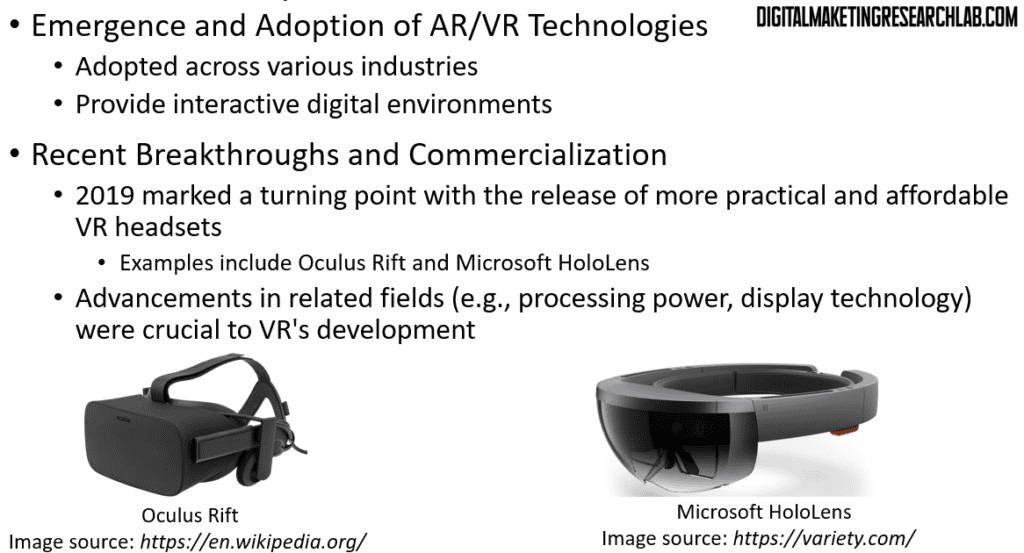
The Different Realities
There are three main types of reality technologies, each offering unique capabilities and applications:
Augmented Reality (AR): This technology enhances the real environment by overlaying digital content onto the user’s view of the physical world. AR typically only requires a mobile phone or tablet, making it one of the most accessible forms of reality technology.
Virtual Reality (VR): VR immerses the user in a fully digital world, completely replacing their view of the physical environment. This technology requires a headset to provide a fully immersive experience.
Mixed Reality (MR): Also known as hybrid reality, MR blends physical and digital worlds, allowing users to see and interact with digital content while still being aware of and present in their physical surroundings. MR typically requires a headset or specialized display system.
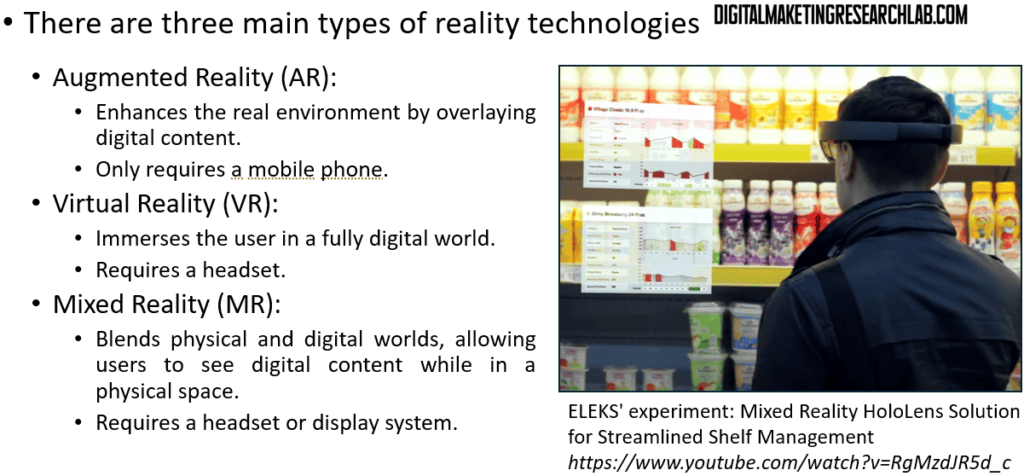
Virtual reality is defined as a computer-generated simulation of an environment where the user experiences a sense of telepresence – the feeling of being present in a different location or reality. This immersive experience is created through a combination of visual, auditory, and sometimes haptic feedback.
Researchers have identified six dimensions of presence in virtual environments, which help to create a compelling and realistic experience:
1. Presence as social richness: This dimension provides a sense of intimacy and immediacy, bringing the user closer to the virtual environment or brand being presented.
2. Presence as realism: This aspect focuses on producing realistic representations within the virtual world, enhancing the user’s sense of being in a real environment.
3. Presence as transportation: This dimension makes users feel as if they have been transported to another place, enabling a sense of escape or exploration.
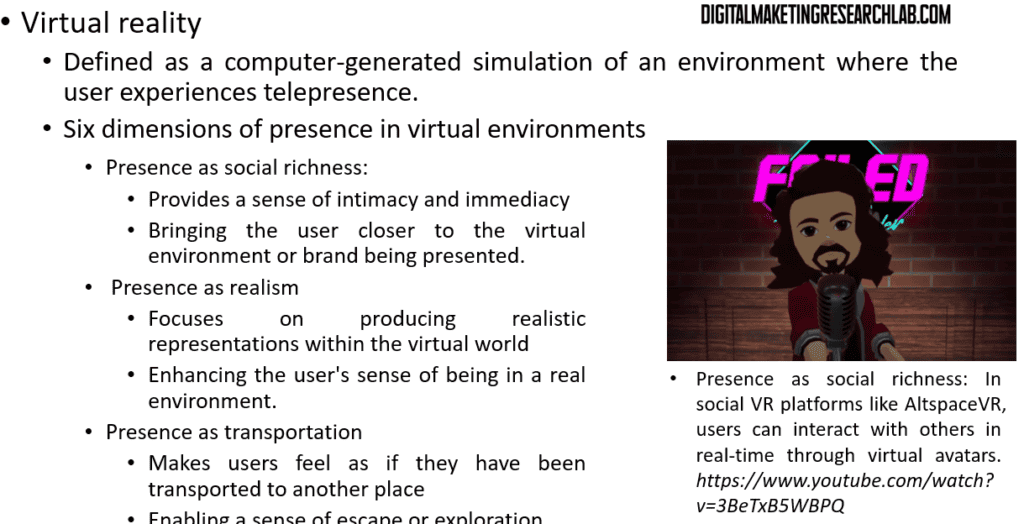
4. Presence as immersion: This aspect fully engages users in the experience, capturing their attention and senses to create a compelling virtual world.
5. Presence as social actor: In this dimension, users respond to social cues within the virtual environment, interacting with virtual characters or other users as they would in the real world.
6. Presence as medium as social actor: This final dimension involves users responding to the external devices themselves (such as the VR headset) as if they were social entities.
These dimensions work together to create a convincing and engaging virtual reality experience, each contributing to the overall sense of presence and immersion.

Augmented reality overlays digital content onto the real environment, enhancing the user’s perception and interaction with the world around them. Unlike VR, which replaces the real world entirely, AR adds to it, providing additional information or visual elements that complement the physical environment.
AR can significantly increase engagement by providing richer, more immersive content. It allows users to interact with digital elements in their real-world context, opening up numerous possibilities for marketing, education, and entertainment applications.
The accessibility of AR technology, often requiring only a smartphone or tablet, has contributed to its rapid adoption across various industries. From trying on virtual makeup to visualizing furniture in your home before purchase, AR is transforming how consumers interact with products and brands.

Mixed reality, sometimes referred to as hybrid reality, blends virtual and augmented reality, allowing digital and physical objects to coexist and interact in real time. This technology creates a new environment where physical and digital objects can interact, offering unique possibilities for both consumers and businesses.
MR is sometimes also referred to as extended reality (XR), encompassing all immersive technologies that blend the physical and digital worlds. As MR technology continues to develop, it promises to offer even more seamless integration between our physical surroundings and digital information or interactions.

Application of Realities in Marketing
When considering the implementation of new technologies like VR and AR, it’s important to understand their maturity and readiness for real-world application. The Technology Readiness Level (TRL) scale is a useful tool for this assessment.
The TRL scale ranges from 1 to 9, with 1 representing the earliest stage of technology development (basic principles observed) and 9 representing the most mature stage (actual system proven through successful operation). This scale helps organizations understand the current state of a technology and the steps needed to bring it to full implementation.
In the case of VR technology, it took nearly 50 years to progress from early prototypes (TRL 1-4) to consumer-ready products (TRL 8-9). This lengthy development period illustrates the complexity involved in bringing cutting-edge technologies to market, and the importance of continued research and development in advancing new technologies.
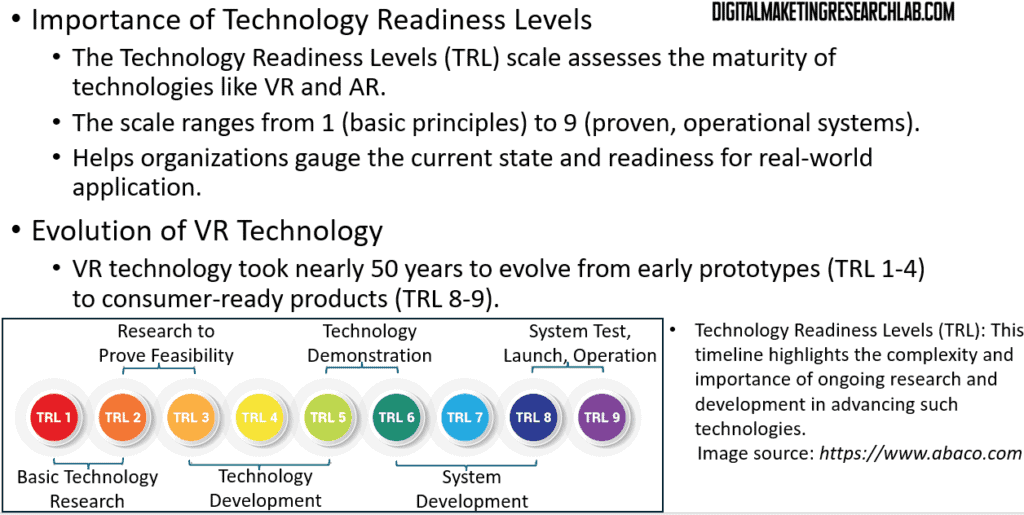
Key Concepts in the Realities
Understanding key theoretical concepts is crucial for effectively implementing AR, VR, and MR technologies in marketing and other applications.
A useful framework for understanding consumer experiences in retail environments, which can be applied to virtual and augmented reality experiences, includes four quadrants:
1. Playfulness (intrinsic/active): This refers to the enjoyment and hedonic benefits of the shopping or brand experience. In the context of VR and AR, this could relate to the fun and engaging aspects of using the technology itself.
2. Aesthetics (intrinsic/reactive): This dimension concerns the visual appeal of the retail environment or, in the case of VR/AR, the quality and appeal of the virtual or augmented elements.
3. Consumer return on investment (extrinsic/active): This relates to the utilitarian benefits that consumers derive from the experience. In VR/AR applications, this could be the practical value of being able to visualize products in one’s own space or try on clothes virtually.
4. Service excellence (extrinsic/reactive): This dimension focuses on the quality of service provided. In VR/AR contexts, this could relate to the responsiveness and effectiveness of the technology in meeting the user’s needs.
Understanding these experiential values can help marketers design more effective and engaging VR and AR experiences that resonate with consumers.
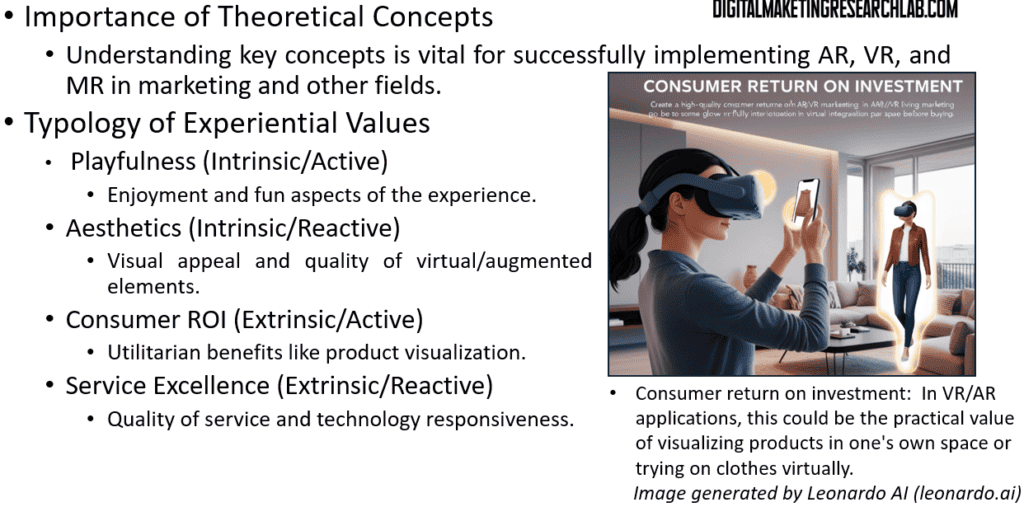
When developing AR/VR applications, it’s important to consider six key dimensions of interactivity:
1. Choice of available options: This relates to the range of choices or actions available to users within the VR/AR environment.
2. Effort users must exert: This dimension considers how much effort users need to put in to navigate and use the VR/AR application.
3. Responsiveness to user: This refers to how quickly and accurately the system responds to user inputs or actions.
4. Monitoring of information use: This dimension involves tracking how users interact with the VR/AR environment, which can provide valuable data for improvement and personalization.
5. Ease of adding information: This considers how easily users can contribute or customize content within the VR/AR experience.
6. Facilitation of interpersonal communication: This dimension looks at how the VR/AR application enables users to communicate with each other, if applicable.
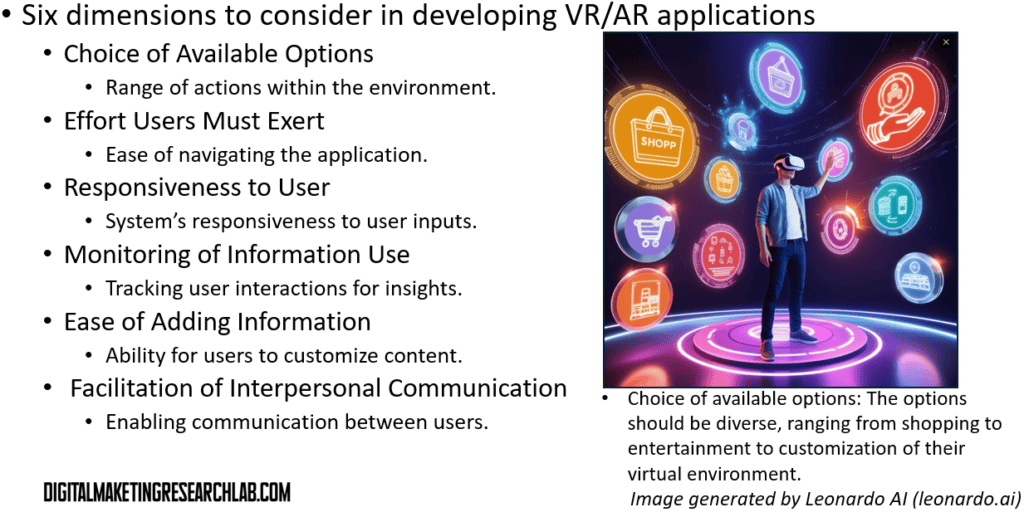
Evaluation of the Realities
Key benefits of AR and VR for marketing include:
Contributing to the customer journey: These technologies can enhance various stages of the customer journey, from initial awareness through to purchase decision and post-purchase experience.
Adding rich information to settings: AR and VR can provide additional layers of information to products or environments, enhancing the user’s understanding and engagement.
Providing good data on user behavior: These technologies offer unique opportunities to gather detailed data on how users interact with products or environments, providing valuable insights for marketers.
Offering environmental benefits: Virtual experiences, such as virtual tourism, can reduce the need for physical travel, potentially offering environmental benefits.
Enhancing product visualization: AR and VR allow customers to visualize products in their own environments or on themselves, potentially reducing return rates and improving customer satisfaction.
Creating memorable brand experiences: Immersive AR and VR experiences can create strong, lasting impressions on consumers, enhancing brand recall and loyalty.
While AR, VR, and MR offer many benefits, there are also challenges to consider:
Access to necessary equipment for consumers: VR, in particular, often requires specialized equipment that many consumers may not have access to, limiting its reach.
High development costs: Creating high-quality AR and VR experiences can be expensive, requiring specialized skills and technology.
Ensuring consumer acceptance and adoption: As with any new technology, there can be a learning curve for consumers, and companies need to ensure that their AR/VR offerings provide clear value to encourage adoption.
Technical limitations: Current AR and VR technologies still have limitations in terms of resolution, field of view, and comfort during extended use.
Privacy concerns: The data collection capabilities of AR and VR technologies may raise privacy concerns among some users.
Content creation challenges: Creating compelling, high-quality content for AR and VR can be more complex and time-consuming than for traditional media.

The Future of Reality
The future of AR, VR, and MR technologies looks promising, with continued growth and development expected in the coming years. Several factors are likely to drive this growth:
Improved hardware: As VR headsets become more comfortable, lightweight, and affordable, adoption rates are likely to increase.
Advances in wireless technology: The rollout of 5G networks will enable faster, more responsive AR and VR experiences, particularly for mobile applications.
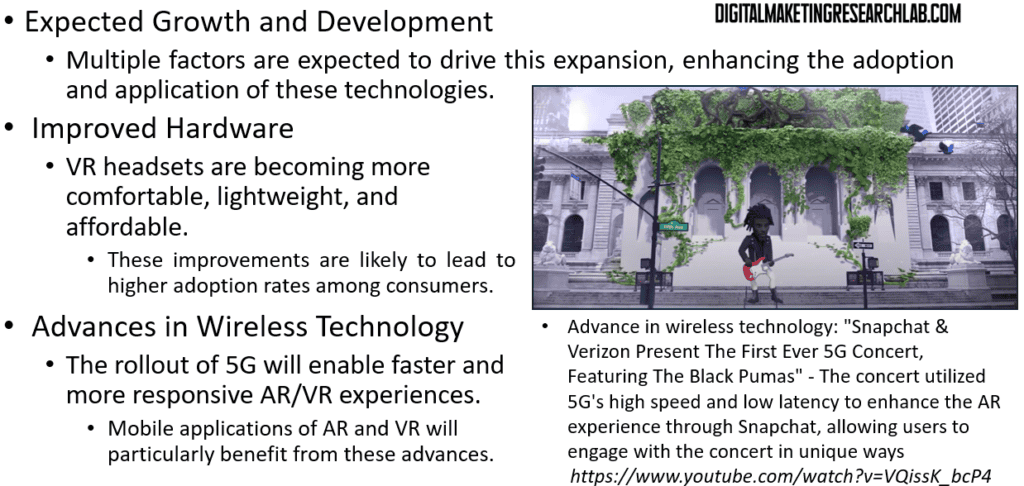
Integration with other technologies: AR and VR are likely to become increasingly integrated with other emerging technologies such as artificial intelligence and the Internet of Things, opening up new possibilities for immersive, context-aware experiences.
Standardization: As the industry matures, we may see more standardization in AR and VR development platforms, making it easier and more cost-effective to create content.
Emerging technologies like skin electronics may eventually allow for AR/VR experiences without the need for external devices, further lowering barriers to adoption.
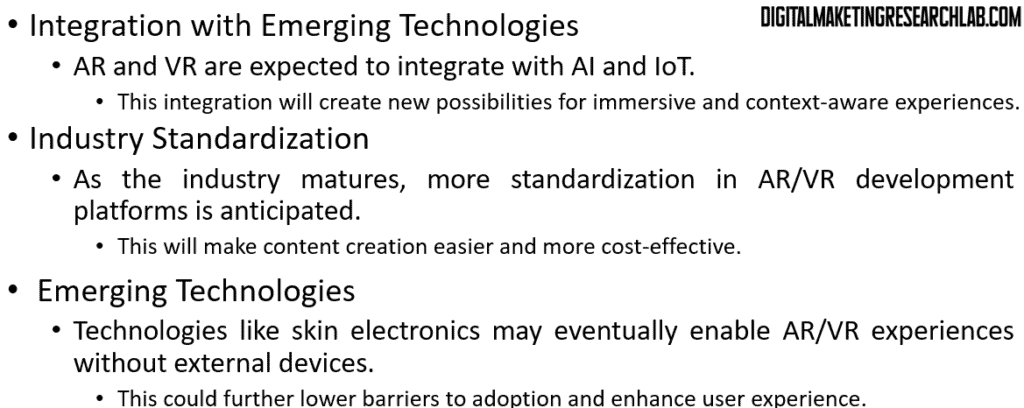
Conclusion
In conclusion, augmented, virtual, and mixed reality technologies offer exciting opportunities for marketers to enhance customer experiences and engagement across many industries. While challenges remain, continuing advances in technology are making these immersive experiences increasingly accessible and impactful for consumers. As these technologies continue to evolve, they are likely to play an increasingly important role in marketing strategies and consumer interactions across a wide range of sectors.
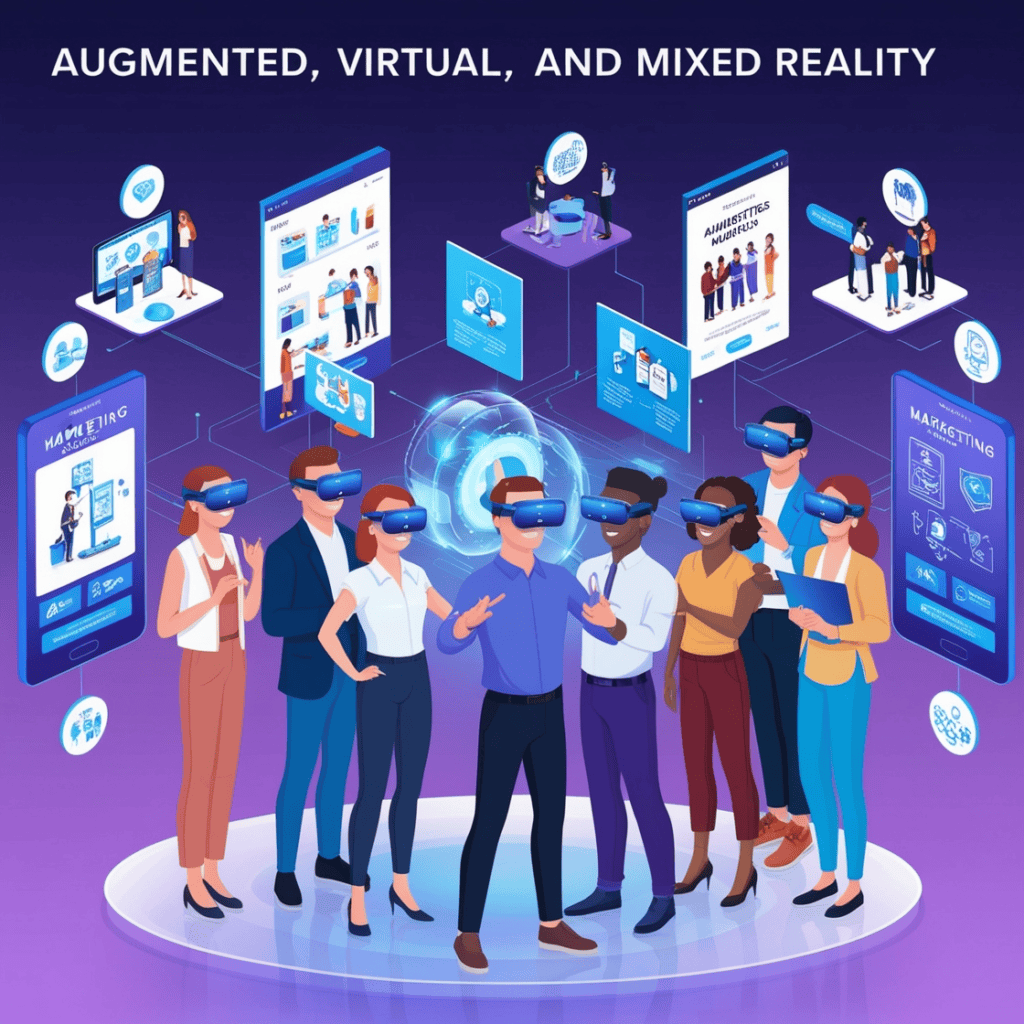
*Reference
Hanlon, A. (2021). Digital marketing: strategic planning & integration. Sage.